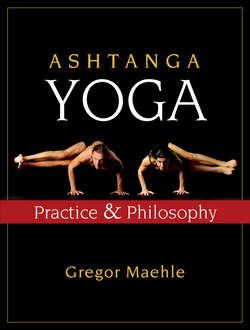Читать книгу Ashtanga Yoga - Gregor Maehle - Страница 21
На сайте Литреса книга снята с продажи.
Vinyasa Count
ОглавлениеIn colloquial language today, the term vinyasa is taken to refer to the jumping back and jumping through between the sides of postures (half vinyasa) and the movement that brings us to standing between postures (full vinyasa).
In the ancient treatise Yoga Korunta, vinyasa refers to every counted movement, accompanied by breath and focal point. The vinyasa count is a format in which the Rishi Vamana recorded the Ashtanga practice in the Yoga Korunta.
Each movement that is needed to enter and exit a posture in the traditional way is counted. Since the postures differ greatly not only from each other but also in the way in which they are entered and exited, they also differ very much in regard to the number of sequential movements that are needed to perform them (their vinyasa counts). So Padangushtasana has only three vinyasas (counted movements) whereas Supta Padangushtasana has twenty-eight. All vinyasas are flowing movements. The only one that is held is the vinyasa where we are in the state of the asana. To be in the state of the asana means to be in and to hold a posture. For Padangushtasana, for example, this is vinyasa three. This vinyasa is held usually for five breaths, though for therapeutic purposes it may be held for twenty-five breaths or more. The fact that one vinyasa may consist of up to twenty-five breaths leads us to the understanding that vinyasa count and the number of breaths, the breath count, are not identical.
In the following section I describe the postures following the half-vinyasa count. That is the way I learned it in Mysore and it is the normal mode of practice today.
To make this text more accessible to beginners I have counted the vinyasas in English. The original vinyasa count is, however, in Sanskrit, and it is important to preserve this precious tradition. Accordingly, I use the Sanskrit count when I conduct a vinyasa-count class. For those who want to study the vinyasa count more closely, I recommend K. Pattabhi Jois’s Yoga Mala and Lino Mieles’s Ashtanga Yoga.
1. The expression ‘yoga mala’ was coined by Shri K. Pattabhi Jois, and he is the author of a book with that title.
2. Prana has another meaning in the context of the principle of the ten individual currents within the life force, where it has reference to inhaling only.
3. The origin of a muscle is the end that is closer to the center of the body, called the proximal end; its insertion is the end more distant from the center of the body, called the distal end.
4. Yoga Sutra I.41.
5. Hatha Yoga Pradipika IV.24, trans. Pancham Sinh, Sri Satguru Publications, Delhi, 1915, p. 50.
6. Yoga Sutra II.47.
7. This process is described by Andre Van Lysbeth in his book Die grosse Kraft des Atems, which he wrote after he studied with K. Pattabhi Jois in the 1960s.
8. Hatha Yoga Pradipika III.56.
9. Hatha Yoga Pradipika III.73.
10. Hatha Yoga Pradipika IV.17.
11. Yoga Sutra I.2.
12. Yoga Yajnavalkya, trans. A. G. Mohan, Ganesh & Co., Madras, pp. 81–82.
13. Aparokshanubhuti of Sri Shankaracharya, trans. Sw. Vimuktananda, Advaita Ashrama, Kolkata, 1938, p. 63.
14. Brahma Sutra I.I.23.
15. Chandogya Upanishad I:II:5.
16. G. C. Adams, Jr., trans. and comment, Badarayana’s Brahma Sutras, Motilal Banarsidass, Delhi, 1993, p. 60.
17. Yoga Sutra II.48.
